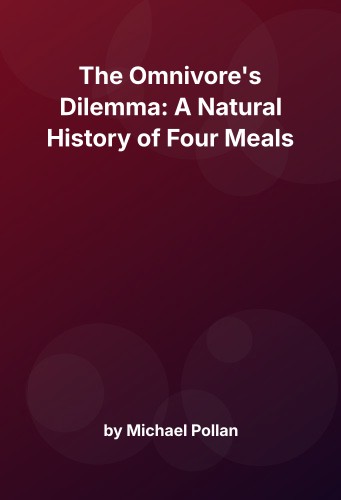Summary of “The Omnivore’s Dilemma”
Michael Pollan’s “The Omnivore’s Dilemma” addresses the complexities of food choices and the modern food chain. The book is structured around the exploration of four meals, each representing different food production systems: industrial farming, organic and alternative food chains, and foraging. Pollan’s investigation takes readers from cornfields to fast food restaurants, organic farms, and even into the forest to hunt and gather.
Core Frameworks and Concepts
Pollan’s work is grounded in the omnivore’s dilemma: the challenge of choosing what to eat when one has so many options. This dilemma is intensified by the modern food industry, which obscures the origins and processes behind food production. Pollan uses several frameworks to dissect this complexity:
1. The Industrial Food Chain
Pollan begins by examining the industrial food chain, particularly how corn has become a staple in the American diet. This section highlights the monoculture practices that dominate American agriculture and their environmental implications. Pollan’s analysis is not unlike that in “Fast Food Nation” by Eric Schlosser, which similarly criticizes the fast-food industry’s impact on health and the environment. Both authors highlight the hidden costs associated with cheap and convenient food, such as environmental degradation and public health crises.
Example: Pollan uses the example of a simple McDonald’s meal to illustrate how deeply embedded corn is in the food system. From the corn-fed beef in the hamburger to the high-fructose corn syrup in the soda, corn derivatives are ubiquitous.
2. The Organic Movement
In contrast to industrial agriculture, Pollan explores organic farming. He distinguishes between large-scale organic operations and small, sustainable farms, pointing out that even organic labels can sometimes obscure industrial practices. This comparison is reminiscent of “Animal, Vegetable, Miracle” by Barbara Kingsolver, where Kingsolver documents her family’s efforts to eat locally and sustainably, emphasizing community-supported agriculture (CSA) as a viable alternative.
Example: Pollan visits Polyface Farm, a model for sustainable agriculture, where he observes a system that mimics natural ecological cycles. This farm serves as an example of how farming can be both productive and environmentally sustainable.
3. The Local Food Movement
Pollan delves into the burgeoning local food movement, arguing for the benefits of eating locally sourced foods. He notes that local food systems reduce the carbon footprint associated with transporting food over long distances and strengthen local economies.
Example: In his exploration of local food systems, Pollan participates in a “locavore” meal, where all ingredients are sourced from nearby farms. This meal demonstrates the feasibility and benefits of prioritizing local produce.
4. Foraging and Self-Sufficiency
Pollan concludes with a personal foraging adventure, hunting wild pigs and gathering mushrooms. This section emphasizes the primal connection humans have with their food sources and the satisfaction derived from self-sufficiency. It draws parallels to “Walden” by Henry David Thoreau, where Thoreau champions living deliberately and relying on one’s own skills to procure food.
Example: Pollan’s hunting experience underscores the direct relationship between humans and their environment, contrasting sharply with the detachment fostered by the industrial food chain.
5. Ethical and Environmental Considerations
Throughout the book, Pollan raises ethical questions about food choices, animal welfare, and environmental stewardship. He challenges readers to consider the broader implications of their dietary habits.
Example: Pollan discusses the ethical implications of factory farming, advocating for more humane treatment of animals and environmentally conscious farming practices.
Key Themes
1. The Impact of Corn
Pollan’s analysis begins with corn, illustrating its dominance in the American diet. The crop’s versatility and government subsidies have made it a cornerstone of industrial agriculture, but this has come at a significant environmental and health cost.
2. Transparency in Food Production
A recurring theme is the lack of transparency in the food industry. Pollan argues that consumers are often unaware of the processes involved in food production, leading to ill-informed choices.
3. The True Cost of Cheap Food
Pollan emphasizes that the low cost of industrially produced food does not reflect its true cost, which includes environmental damage, health issues, and ethical concerns.
4. The Value of Sustainable Practices
Pollan advocates for sustainable agricultural practices, highlighting their benefits for the environment, public health, and local communities.
5. Food and Identity
Pollan explores the cultural and personal significance of food, suggesting that our food choices are a reflection of our values and identity.
6. The Role of Government and Policy
Pollan critiques governmental policies that favor industrial agriculture over sustainable practices, calling for reforms that support small-scale farmers and local food systems.
7. The Power of Consumer Choice
Pollan empowers readers by suggesting that their food choices can drive change in the industry, encouraging a shift towards more ethical and sustainable food systems.
8. Ethical Eating
The book stresses the importance of making ethical eating choices, considering the welfare of animals and the impact on the environment.
Final Reflection
“The Omnivore’s Dilemma” challenges readers to rethink their relationship with food, advocating for more informed and responsible choices. By examining different food production systems, Pollan encourages a critical assessment of the industrial food chain and its alternatives. This reflection is not just about food—it extends to broader themes of sustainability and ethical consumerism, which are relevant across various domains such as leadership, design, and change management. Like a leader choosing a path for their organization, consumers wield significant influence through their choices, shaping the food industry and its impact on the world. Pollan’s work is a call to action, urging individuals to consider the broader implications of their dietary habits and to advocate for a food system that is sustainable, ethical, and transparent.

